Generally, when I’m calling out to view new beef sheds, they are modest in scale in line with average suckler herds being around the 20-cow mark.
The shed recently constructed on the farm just outside Limerick city, is far from modest, boasting two seven-bay double slurry tanks with penning above for over 340 finishing cattle and three feed passages.
While the farmer was happy to have the shed featured, they wished to remain anonymous.
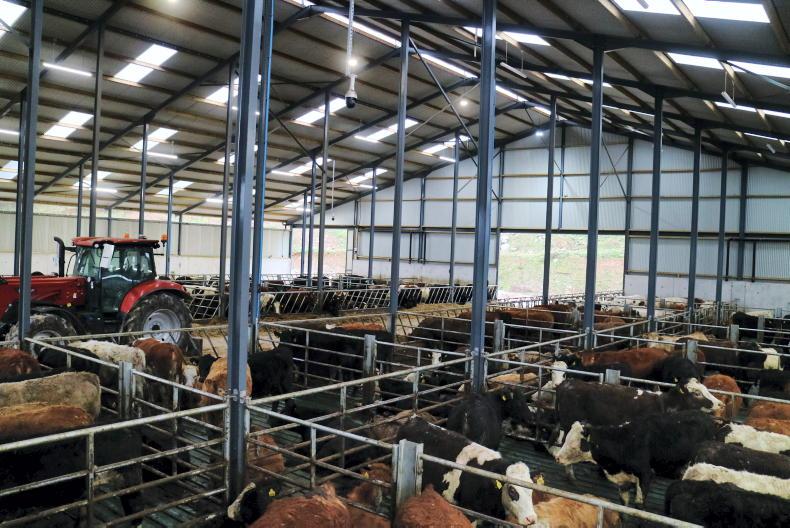
There are 28 separate pens within the shed, with each pen capable of holding 10 to 12 animals.
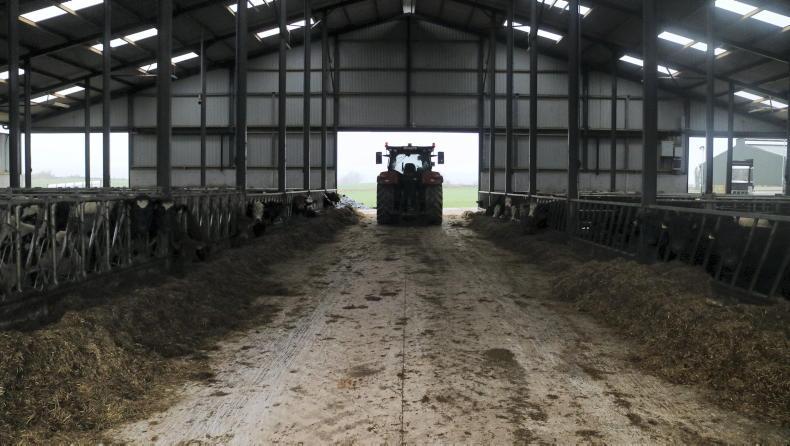
The central passage is 6m (20ft) in width for ease of feeding with the farm diet feeder.
While the shed will primarily be used for weanlings and finishing stock, some suckler cows are also kept, with some of the penning and layout designed around calving and creep areas as well.
Shed layout
With a shed of this width (38.28m), a lot of upright stanchions are required.
A line of RSJs runs along the perimeter wall, another between the outer feed passage and first pen, a further line running along the spine wall between the two tanks with the final line each side of the central passage, giving a total of eight stanchions/bay or 64 for the entire shed.

X-bracing has been fitted between the stanchions and between the roof’s steel rafters, as required.
The shed is designed in such a way that all cattle can easily be fed with the farm’s diet feeder, with the noticeably wide passageways designed to give ample room.
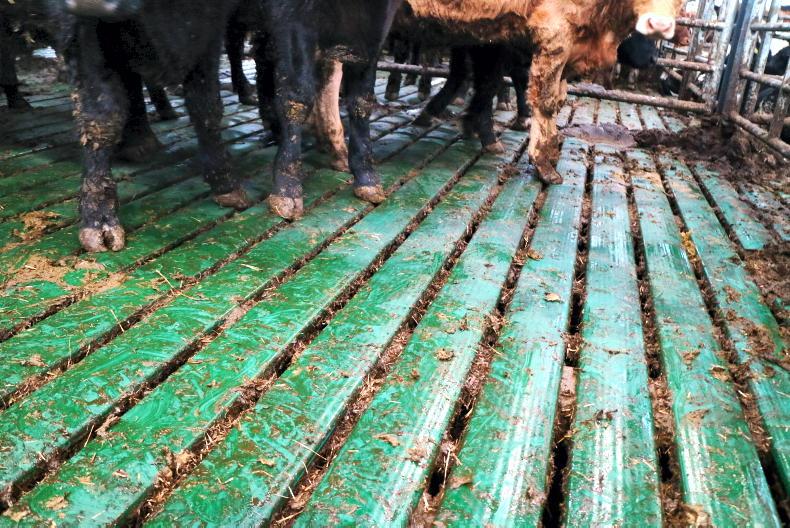
ICE comfort slat mats were installed in all pens for improved animal comfort.
Through the centre of the shed lies a 6m wide passage, with cattle housed each side of this over a double slatted tank. Behind both sides of penning is another feed passage, meaning there is access to feed each side of the tank. In total, there is 134.4m of feeding space in the shed.
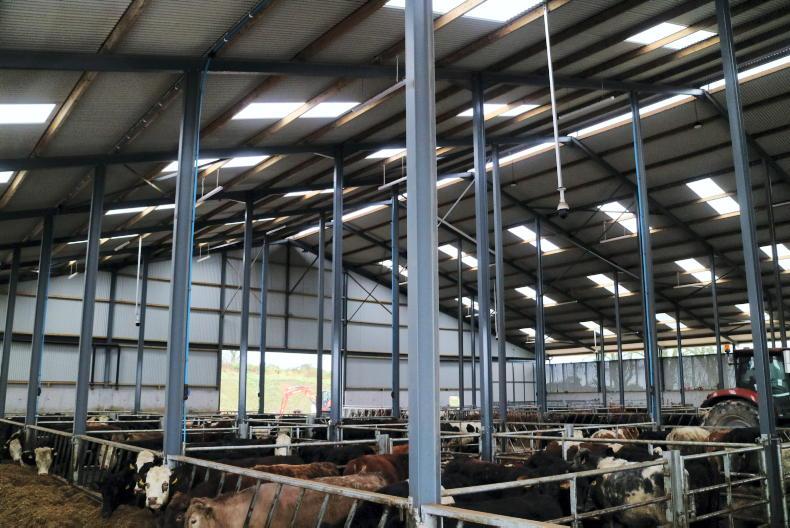
A total of 42 skylights in the shed keep it bright and comfortable for the livestock and farmer alike.
Penning
Each bay is a standard 4.8m wide, with a 16ft 6in (5.07m) long slat used, to give a total pen area of 24.36m², enough lying space for 10 to 12 animals per pen. No toe space was installed, with the slat coming right up against the barrier.

A mixture of fixed and locking barriers, sourced from O’Donovan Engineering, were installed in the shed.
Each bay is split in its two respective pens by a solid and a swinging gate, with an option being to tie back the swinging gate and create a double pen 4.8m x 11.4m.
The pens running parallel to each other are also split with a solid and swinging gate, so an additional option is to create a double pen this way.
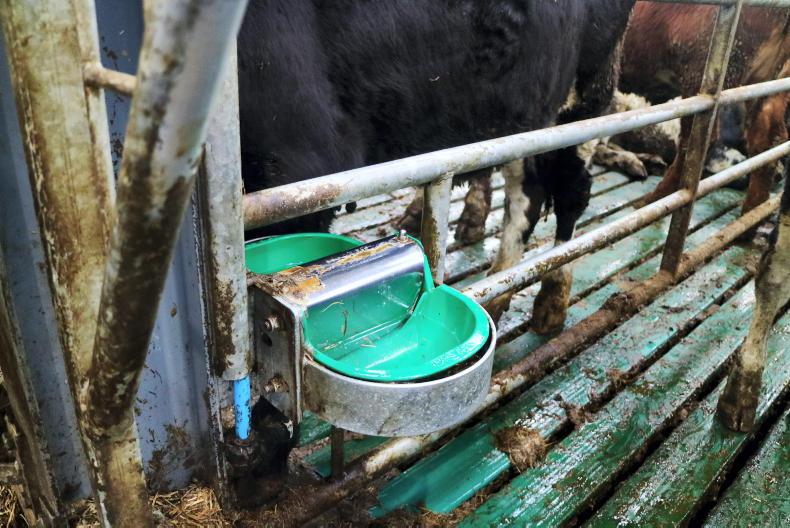
The flexibility surrounding penning with the swinging gate means cattle are easily moved between pens, but it is also simple and safe to create larger pens and groups of cattle.
With the shed being used for a mix of finishing and suckler cows, the farmer was keen to have high comfort levels for stock. All slats were fitted with Irish Custom Extruders Ltd (ICE) comfort slat mats as a result.
Creep and calving areas
The feed barriers are mainly diagonal, but with some of the shed designated to the suckler herd, three bays of the shed on one side have been fitted with locking barriers and creep gates, all sourced from O’Donovan Engineering, Co Cork. A doorway cut into the gable wall on one of these pens can also accommodate creep grazing of calves.
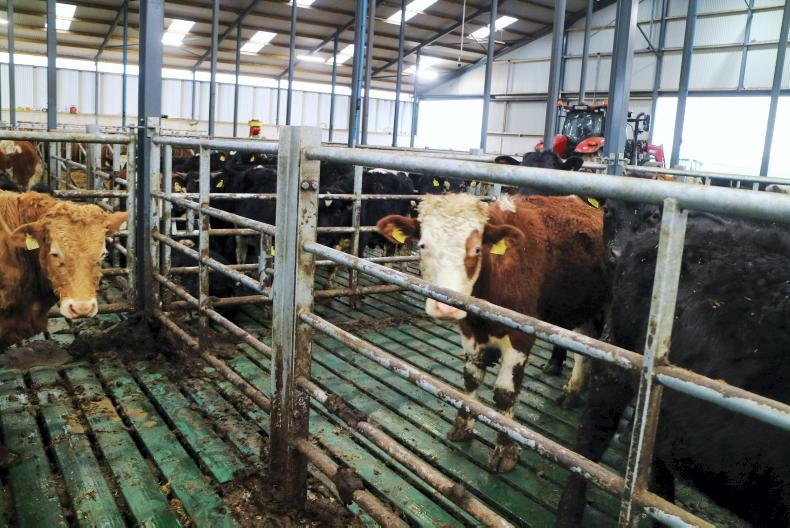
Pen divisions are split, with a solid and swinging gate making it safe and easy to move cattle between pens.
To the rear of these pens, two dry-bedded calving/creep areas, with a calving gate dividing them, have been installed. The entire shed is well equipped for livestock monitoring with four rotating cameras overhead, as well as a total of 42 LED lights.
Ventilation
With a shed of this size with such a volume of cattle, ventilation could easily be inadequate.
However, the farmer has created large inlets and outlets to keep the inside the shed filled with cool, fresh air, even when at its stocking capacity.
Vented sheeting is fitted along each side of the shed, in addition to a ventilation gap measuring 750mm in height between the top of the side sheeting and the eaves. The roof of the shed has been extended over the wall to prevent rain entering through this gap along the eaves.
A ridge opening acts as the air outlet, and although it is covered with a ridge cap there is a clear gap of 425mm between it and the roof sheeting to prevent obstruction of air flow.
Slurry storage and handling
A large volume of slurry storage was required to the storage needs in line with the stocking capacity of the pens.
Each tank holds approximately 418m³of slurry, with the four tanks in total holding 1,672m³, or just over 440,000 gallons.
Taking 200mm of freeboard in to account, there is 1,536m³ of usable storage available.
With the farm based in Co Limerick, he requires 18 weeks of storage. At a requirement of 0.26m³ per finishing animal/week, the farmer has ample storage for 328 animals.
Agitation points are installed at the end of each tank, but these serve only as a back up as the farmer opted to install an aeration system, sourced from Linton and Robinson, Northern Ireland.
The main reason the farmer opted for installing an aeration system was safety. “With me having young kids about, I wanted to increase the safety on farm, so installing an aeration system was primarily for safety. It will also be extremely handy to follow cattle around with a slurry tanker without having to agitate all the time,’’ he stated.
Price
While the final pricing of the shed is yet to be completed, with some works still under way with a rainwater harvesting system, the whole unit is set to cost in excess of €500,000.
The magnitude of inflation can really be seen in the price of the steel installed, with the farmer purchasing the steel prior to installing the slurry storage tanks, and having it stored. In the 18 months between purchasing and using the steel, the cost had risen by €79,000.
The shed is impressive in scale and finish, even more so when you consider it being built without any TAMS aid. Despite the farmer not opting for TAMS, the shed is built nearly to grant spec, save for the galvanising of the structural steel.
What is most notable about the shed is that despite there being a large volume of storage installed, the usable volume is just shy of being sufficient.
The key to maximising storage is to keep tanks wide and deep, but even with a 16ft 6in slat used it can be difficult.
Generally, when I’m calling out to view new beef sheds, they are modest in scale in line with average suckler herds being around the 20-cow mark.
The shed recently constructed on the farm just outside Limerick city, is far from modest, boasting two seven-bay double slurry tanks with penning above for over 340 finishing cattle and three feed passages.
While the farmer was happy to have the shed featured, they wished to remain anonymous.

There are 28 separate pens within the shed, with each pen capable of holding 10 to 12 animals.

The central passage is 6m (20ft) in width for ease of feeding with the farm diet feeder.
While the shed will primarily be used for weanlings and finishing stock, some suckler cows are also kept, with some of the penning and layout designed around calving and creep areas as well.
Shed layout
With a shed of this width (38.28m), a lot of upright stanchions are required.
A line of RSJs runs along the perimeter wall, another between the outer feed passage and first pen, a further line running along the spine wall between the two tanks with the final line each side of the central passage, giving a total of eight stanchions/bay or 64 for the entire shed.

X-bracing has been fitted between the stanchions and between the roof’s steel rafters, as required.
The shed is designed in such a way that all cattle can easily be fed with the farm’s diet feeder, with the noticeably wide passageways designed to give ample room.

ICE comfort slat mats were installed in all pens for improved animal comfort.
Through the centre of the shed lies a 6m wide passage, with cattle housed each side of this over a double slatted tank. Behind both sides of penning is another feed passage, meaning there is access to feed each side of the tank. In total, there is 134.4m of feeding space in the shed.

A total of 42 skylights in the shed keep it bright and comfortable for the livestock and farmer alike.
Penning
Each bay is a standard 4.8m wide, with a 16ft 6in (5.07m) long slat used, to give a total pen area of 24.36m², enough lying space for 10 to 12 animals per pen. No toe space was installed, with the slat coming right up against the barrier.

A mixture of fixed and locking barriers, sourced from O’Donovan Engineering, were installed in the shed.
Each bay is split in its two respective pens by a solid and a swinging gate, with an option being to tie back the swinging gate and create a double pen 4.8m x 11.4m.
The pens running parallel to each other are also split with a solid and swinging gate, so an additional option is to create a double pen this way.

The flexibility surrounding penning with the swinging gate means cattle are easily moved between pens, but it is also simple and safe to create larger pens and groups of cattle.
With the shed being used for a mix of finishing and suckler cows, the farmer was keen to have high comfort levels for stock. All slats were fitted with Irish Custom Extruders Ltd (ICE) comfort slat mats as a result.
Creep and calving areas
The feed barriers are mainly diagonal, but with some of the shed designated to the suckler herd, three bays of the shed on one side have been fitted with locking barriers and creep gates, all sourced from O’Donovan Engineering, Co Cork. A doorway cut into the gable wall on one of these pens can also accommodate creep grazing of calves.

Pen divisions are split, with a solid and swinging gate making it safe and easy to move cattle between pens.
To the rear of these pens, two dry-bedded calving/creep areas, with a calving gate dividing them, have been installed. The entire shed is well equipped for livestock monitoring with four rotating cameras overhead, as well as a total of 42 LED lights.
Ventilation
With a shed of this size with such a volume of cattle, ventilation could easily be inadequate.
However, the farmer has created large inlets and outlets to keep the inside the shed filled with cool, fresh air, even when at its stocking capacity.
Vented sheeting is fitted along each side of the shed, in addition to a ventilation gap measuring 750mm in height between the top of the side sheeting and the eaves. The roof of the shed has been extended over the wall to prevent rain entering through this gap along the eaves.
A ridge opening acts as the air outlet, and although it is covered with a ridge cap there is a clear gap of 425mm between it and the roof sheeting to prevent obstruction of air flow.
Slurry storage and handling
A large volume of slurry storage was required to the storage needs in line with the stocking capacity of the pens.
Each tank holds approximately 418m³of slurry, with the four tanks in total holding 1,672m³, or just over 440,000 gallons.
Taking 200mm of freeboard in to account, there is 1,536m³ of usable storage available.
With the farm based in Co Limerick, he requires 18 weeks of storage. At a requirement of 0.26m³ per finishing animal/week, the farmer has ample storage for 328 animals.
Agitation points are installed at the end of each tank, but these serve only as a back up as the farmer opted to install an aeration system, sourced from Linton and Robinson, Northern Ireland.
The main reason the farmer opted for installing an aeration system was safety. “With me having young kids about, I wanted to increase the safety on farm, so installing an aeration system was primarily for safety. It will also be extremely handy to follow cattle around with a slurry tanker without having to agitate all the time,’’ he stated.
Price
While the final pricing of the shed is yet to be completed, with some works still under way with a rainwater harvesting system, the whole unit is set to cost in excess of €500,000.
The magnitude of inflation can really be seen in the price of the steel installed, with the farmer purchasing the steel prior to installing the slurry storage tanks, and having it stored. In the 18 months between purchasing and using the steel, the cost had risen by €79,000.
The shed is impressive in scale and finish, even more so when you consider it being built without any TAMS aid. Despite the farmer not opting for TAMS, the shed is built nearly to grant spec, save for the galvanising of the structural steel.
What is most notable about the shed is that despite there being a large volume of storage installed, the usable volume is just shy of being sufficient.
The key to maximising storage is to keep tanks wide and deep, but even with a 16ft 6in slat used it can be difficult.












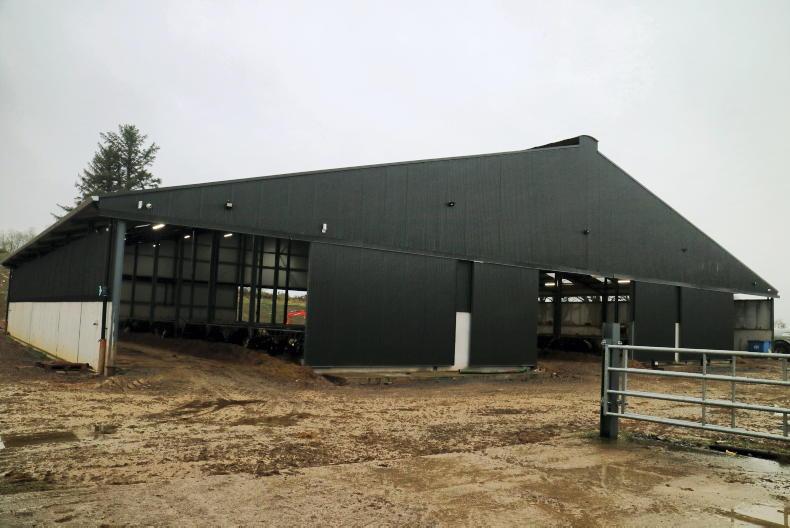
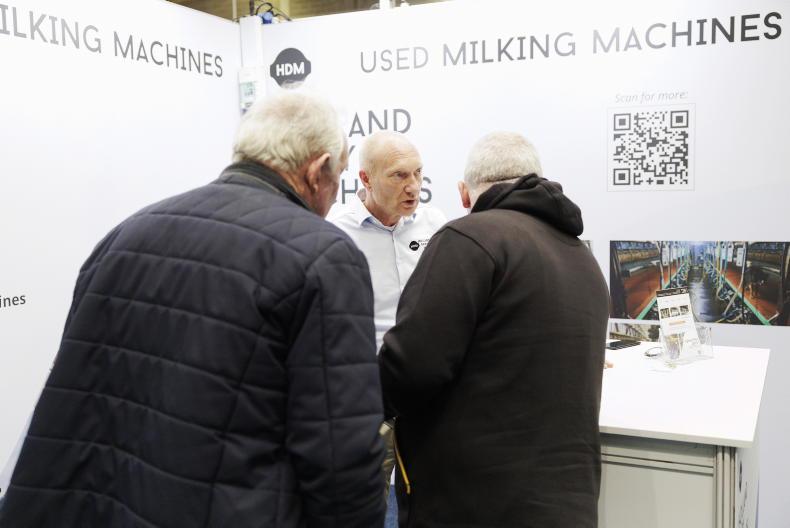
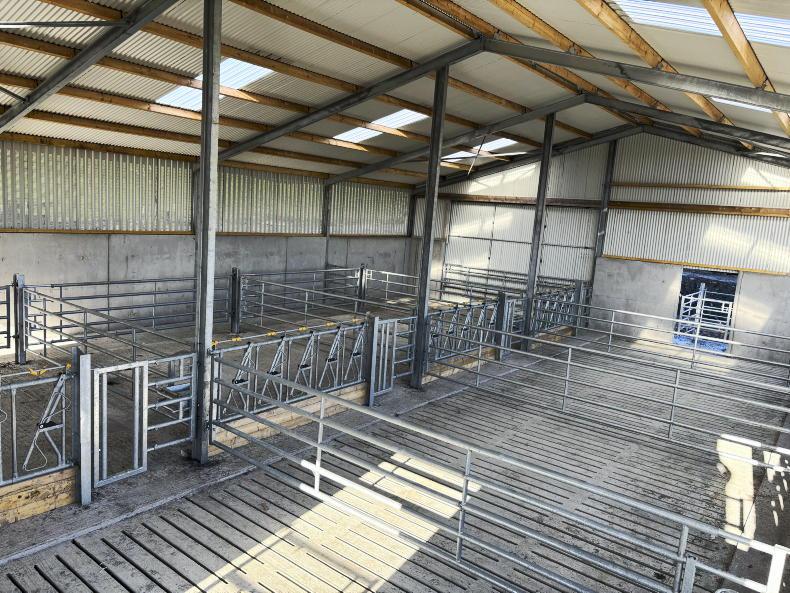
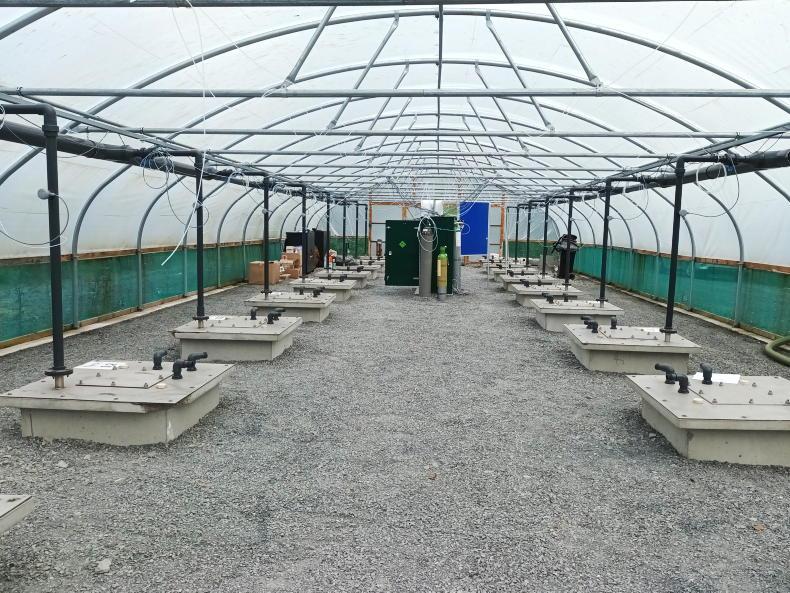
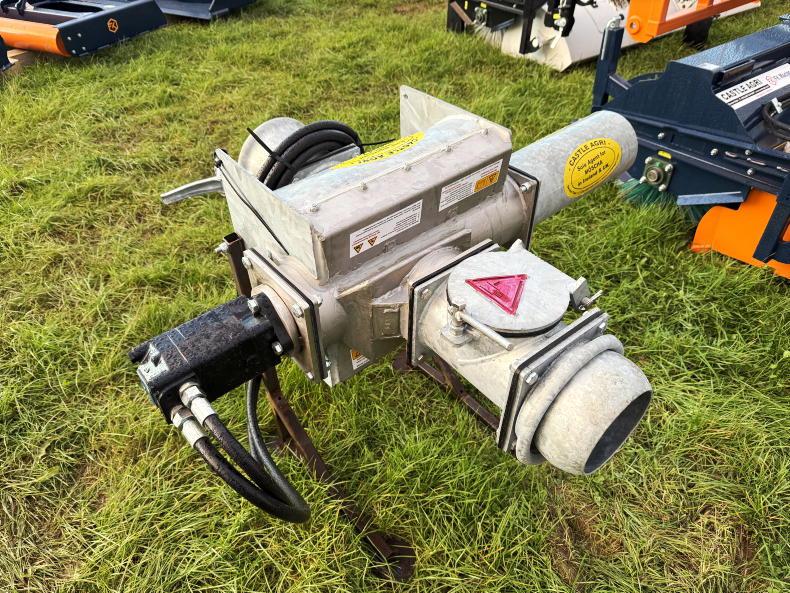
SHARING OPTIONS